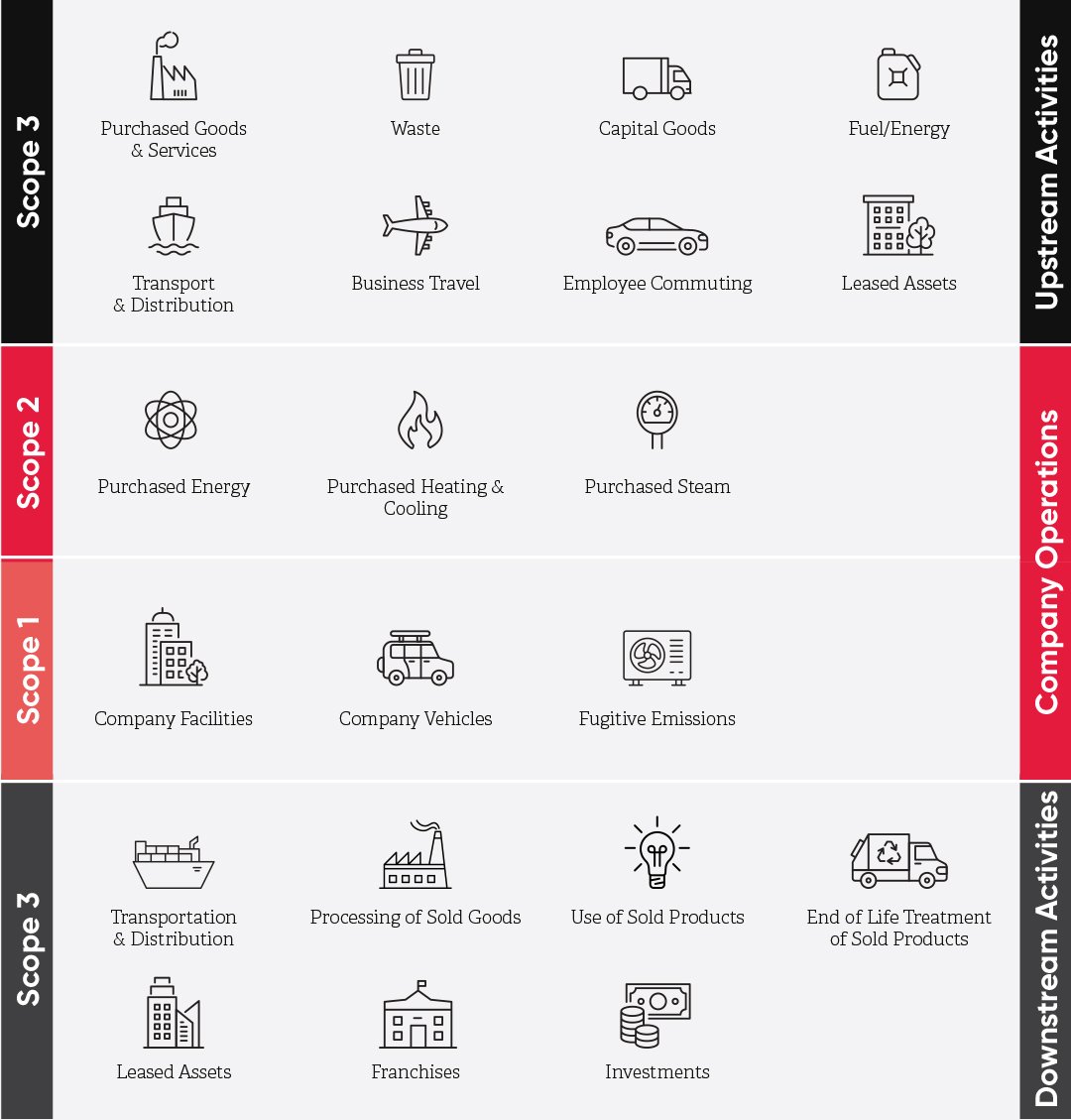GHG emissions reporting is your organisation’s roadmap to a greener future, tracking and managing emissions to combat climate change effectively.
GHG Emissions Reporting


What is it?
Greenhouse Gas (GHG) emissions reporting is the process of documenting the amount of greenhouse gases emitted by a business or organisation, or even a country. This reporting is intended to track and help manage emissions to mitigate climate change impacts.
Do you need help with GHG Emissions Reporting?
We have the expertise to give you the advice that you need to make smart choices for the future.
Get in touch and see what we can do for you.

Documenting these emissions entails calculating, recording, and quantifying the GHG released into the atmosphere as a result of the business’ operations / activities across the value-chain.
The GHG Protocol Corporate Accounting and Reporting Standard is the most widely used framework for measuring and reporting GHG emissions.
It focuses on seven key GHGs covered by the Kyoto Protocol:
- methane (CH4)
- carbon dioxide (CO2)
- nitrous oxide (N2O)
- hydrofluorocarbons (HFCs)
- perfluorocarbons (PFCs)
- nitrogen trifluoride (NF3)
- sulphur hexafluoride (SF6)
Key principles of the Protocol include relevance, completeness, consistency, transparency and accuracy – these should be followed by organisations in
the reporting of GHGs.
GHG emissions reporting operates over a full 12-month period, typically aligned to the financial year of the business.
The Protocol framework characterises emissions in 3 ‘Scopes’ according
to the level of influence the entity has over those emissions
Scope 1: direct emissions that are under the ownership or control of the organisation, such as fuel consumption in company owned vehicles.
Scope 2: indirect emissions resulting from the production of energy that
is brought by the organisation, predominantly electricity used.
Scope 3: refers to indirect emissions resulting from sources not owned
by the organisation within the value chain, including upstream (emissions from suppliers) and downstream (emissions from use of product, end of life/ disposal). This comprises of 15 different categories, as shown below.
Accurate tracking of these Scopes helps monitor the organisation’s impact on climate change and aids in compliance with mandatory regulations or voluntary climate targets.

Why is GHG emissions reporting important?
Reporting GHG emissions is vital for organisations pursuing Environmental, Social and Governance (ESG) goals, providing a clear picture of their environmental impact. In outline, measuring and reporting your emissions will contribute to:
Climate action: helping your organisation to identify carbon reduction opportunities and contribute to mitigating climate change.
Regulatory compliance: supporting adherence to regulations and
helping governments meet the commitments of the Paris Agreement
(Net Zero by 2050).
Stakeholder transparency: investors, customers, and regulators favour organisations that are transparent about their sustainability initiatives
and climate risks.
Risk management: assess the risks associated with climate change, such
as physical damage with weather events or regulatory fines.
Cost savings and operational efficiencies: reducing emissions will results
in lower bills and increase the effectiveness of your operation.
How should you report your GHG emissions?
You should review the GHG accounting standards and methods for organisational reporting, set the agreed base-year (typically aligned
to the financial year) and consider the scope and purpose of the reporting
the GHG emissions.
Adopting a five-step approach can help you implement the GHG Protocol Corporate Accounting and Reporting Standard:
1. Set organisational boundaries
To some extent, the scope of reporting will depend on whether the report is for regulatory compliance, voluntary disclosure or both. Determining which parts of the company will be included in the GHG inventory can be done using the equity share approach (i.e.: the company’s equity share in the operation)
or control approach (its financial or operational control).
This process will
also help you understand the effect of your organisational structures including ownership, legal agreements and joint ventures.
2. Set operational boundaries
This involves categorising emissions into Scope 1 (direct emissions), Scope 2 (indirect emissions from purchased electricity), and Scope 3 (other indirect emissions). Doing so means considering both:
Operational boundaries: understanding both on-site and off-site activities, processes, services, and impacts.
Business context: the nature of activities, geographic locations, industry sectors, purposes of the information, and the intended users of the information.
3. Track emissions over time
Establish a base year and then track emissions over the year to monitor
and identify trends. Consistency is important so that year-on-year accounting is comparable.
As you collect data and quantify your GHG emissions, this will help you to:
- Identify the material scope and categories for the organisation, mapping these
to business activities. - Identify the available data for each scope and category considering the systems and people who hold the data. Note limitations may exist in the first year such
as availability of data and/or cost of gathering data. - Develop a data management framework, with assigned responsibility, processes and systems to help improve this process going forwards. Using available tools and guidance from sources such as the GHG Accounting Protocol.
- Compile, review and assess data quality. Where gaps are identified, develop a plan to improve these, balancing this against the effort / cost to do so and
how material the emission category is (i.e. magnitude of emissions). - Use emissions factors to convert raw data into CO2e (e.g. DEFRA conversion factors for fuel). Note, all GHG emissions are measured in tonnes of carbon dioxide equivalent (tCO2e). The emission factors used depend on the data available; see below list of different types of factors:
- Activity-Based Emission Factors: based on the amount of activity that produces emissions, e.g. distance car travelled.
- Fuel-Based Emission Factors: based on the type and amount of fuel consumed, e.g. quantity of petrol consumed.
- Integrated Emission Factors: These combine multiple sources and processes, such as the entire lifecycle emissions of a product, from raw material extraction to disposal.
- Process-Based Emission Factors: derived from specific industrial processes,
e.g. emissions from steel manufacturing. - Spend-Based Emission Factors: least accurate but often most used. This estimates emissions on the amount of money spent on goods or services,
this is often used for your supply chain emissions using your business P&L.
4. Consolidate data
Aggregate your emissions across all scopes into a unified GHG inventory. Quality assurance and control is key to ensure the reliability of the data with a clear audit trail to enable limited / reasonable assurance. This may include internal reviews and third-party verification – see our Quick Guide to External Assurance & Sustainability Reporting
5. Report and disclose
Compile the aggregated data into your GHG emissions report, ensuring assumptions, limitations, methodologies and data sources are documented clearly for transparency and future audits. It is also recommended that
you create a Net Zero roadmap detailing long-term decarbonisation strategies, identifying available levers and undertaking a cost-benefit analysis to target emission reductions and align with business priorities.
First steps in GHG Reporting
Whether it is realistic for you to undertake a GHG Reporting exercise will depend on the scale, size, complexity and requirements of your business,
as well as your internal resources. There are calculation tools – either open source or private software solutions – which can help, or you can appoint external experts.
The risk of errors and non-compliance with rules often lead organisations to seek assistance and/or third-party verification where assurance is required. This can reduce the potential risk of reputational damage / fines by ensuring accurate, credible and trustworthy disclosures and reporting.
How you can prepare:
- Stay updated on regulations for operational regions.
- Align internal reporting with both local and international requirements, keeping up to date with changes.
Related Quick Guides
Let us Introduce Ourselves
To find your nearest office or get in touch with one of our specialist advisors to see how we can help your business, please go to our contact page.



